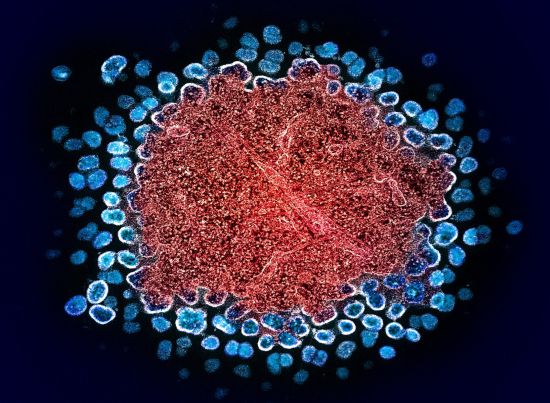Apr 11, 2024
Study confirms how RNA chemical modifications benefit HIV-1
Sequencing of full-length viral RNA reveals molecular-level effect
Emily Caldwell
Ohio State News
caldwell.151@osu.edu

Numerous HIV-1 virus particles replicate from a segment of an H9 T cell, a step in HIV infection supported by the RNA chemical modifications described in the study.
Image: NIAID
A chemical modification in the HIV-1 RNA genome whose function has been a matter of scientific debate is now confirmed to be key to the virus’s ability to survive and thrive after infecting host cells, a new study has found.
This change to HIV-1 RNA, a tiny chemical modification on the adenosine building block of RNA known as m6A, is a common RNA editing process in all life forms that involves altering gene expression and protein production. The functional effect often represents a cellular solution but, in some cases, leads to disease.
 Sanggu Kim
Sanggu Kim
By developing technological advances to observe a full length of HIV-1 RNA, researchers at The Ohio State University discovered the m6A modification occurs nearly exclusively at three specific locations on the HIV-1 RNA genome – out of the total 242 potential sites that can harbor an m6A – and these three m6As are crucial in viral replication. The finding suggested that redundancy was built into the system, and further analyses suggested that is, indeed, the case with HIV-1.
“These sites are very important for producing virus proteins and for producing viral genomic RNA,” said senior study author Sanggu Kim, associate professor of veterinary biosciences and an investigator in the Center for Retrovirus Research at The Ohio State University.
“An intriguing question is, why does HIV maintain multiple m6As? Our conclusion is that m6A is so important that HIV wants to have multiples to have redundancy. If it loses one or two, it’s OK. If it loses all three, it’s a problem.”
Though any drug development associated with this work is years away, Kim said the finding suggests targeting the site-specific m6A modifications could be the basis of designing an important new treatment for HIV infection.
The study is published today (April 11, 2024) in the journal Nature Microbiology.
HIV-1, the most common type of the human immunodeficiency virus, attacks immune cells and uses them to make copies of itself. An estimated 1.2 million people in the United States have HIV, according to the 2023 report from the Centers for Disease Control and Prevention.
The virus is a good example of why research on RNA modification has been getting a lot of attention in recent years, Kim said. Once thought of as the “middle guy” between DNA’s genes and life-sustaining proteins, RNA is now known to contain not just genetic information, but also to possess functional significance – in part because of the chemical modifications that accompany its messenger task.
“Especially because HIV is an RNA virus with a very compact RNA genome, it has to encode all of the survival information within its RNA genome – it’s using not only nucleotide sequences, but all of the chemical and structural features of RNA as codes to execute its infection of host cells,” Kim said. “We know every aspect of RNA function is very important, but we don’t really know how exactly these chemical and structural modifications of RNAs regulate virus infection.”
Though the m6A (short for N6-methyladenosine) modification was known to exist in HIV-1, previous studies had produced conflicting results about whether it helped or harmed the virus, primarily because its location was unknown and efforts to understand its effect were based on knocking out host cell genes rather than mutating the virus genome itself.
Kim and colleagues used – and refined – a technique called nanopore direct RNA sequencing to view a full length of HIV-1’s RNA genome, which is tricky to observe because RNA is a notoriously unstable and complex molecule.
The team first discovered the three m6A modifications and their specific locations. From there, the researchers analyzed individual RNA molecules with distinct ensembles of m6A modifications, including those with multiple m6As and those with just one of the three m6As. They found that any ensemble of m6A modifications, regardless of the number or the position of m6As, produced similar functional changes. Removal of all three, however, caused devastating effects to viruses – a dead giveaway that these m6As are redundant.
“Until now we didn’t know which exact nucleotides are modified and how they function, and how it’s important for viruses or how it’s important for cells. Our paper addresses the keys to these important questions,” Kim said.
“Why would HIV need all three modifications if they’re functioning in the same way?” he said. “Our study is the first to show that HIV-1 utilizes this unique, important mechanism at the RNA level for its evolutionary benefit.”
Almost all existing HIV drugs block virus replication, but no medications inhibit viral RNA and protein production. There is more to learn about the RNA modification in HIV-1, but Kim said the work hints at the potential to develop therapies that could target these later steps.
This research was funded by the National Institutes of Health, U.S. Department of Defense, U.S. Department of Energy and the C. Glenn Barber Fund Trust.
Co-authors include Alice Baek, Ga-Eun Lee, Sarah Golconda, Anastasios Manganaris, Shuliang Chen, Nagaraja Tirumuru, Hannah Yu, Shihyoung Kim, Christopher Kimmel, Olivier Zablocki and Matthew Sullivan of Ohio State, Asif Rayhan and Balasubrahmanyam Addepalli of the University of Cincinnati, and Li Wu of the University of Iowa.
Contact
Emily Caldwell
Assistant Director, Research Communications
The Ohio State University
Office of Marketing and Communications
University Square South, 2nd Floor
15 E. 15th Ave., Columbus, OH 43201
614-292-8152 | Office
caldwell.151@osu.edu / news.osu.edu
Pronouns: she/her
Source: Ohio State News - The Ohio State University https://news.emory.edu/stories/2024/04/hs_together_takemehome_year_update-10-04-2024/story.html
"Reproduced with permission - The Ohio State University"
The Ohio State University
For more HIV and AIDS News visit...
Positively Positive - Living with HIV/AIDS:
HIV/AIDS News
|